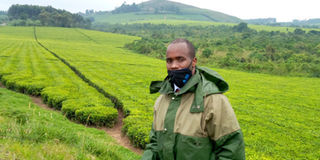A day in the sprawling tea plantations of Kyamuhunga

On a sunny invigorating Thursday morning characterised by songbirds, walkers, on my mind were imaginations of the tea plantations in Kyamuhunga in Bushenyi District.
The previous day, I made an appointment with a boda-boda cyclist to take me to Kyamuhunga. I could not travel by public means due to the fear of contracting Covid-19. This was barely a month after the deadly pandemic claimed a high ranking officer near my town.
At 8am, the neat and friendly lad hooted in my compound. Moments later, I headed out for a one-day expedition in the beautiful tea plantations with a guy, who knew all the areas within Kyamuhunga.
As we rode through Bushenyi and Ishaka, the sun shone brightly on the messy streets, bringing with it a bustle of residents getting started on the morning hustle.
Past Kizinda trading centre, I was treated to isolated tea gardens. From there, tea plantations spanning many miles along the road as gardens presented a magnificent sight.
Maramagambo forest reserve
On the eastern part of the tea estates, stood rolling hills in Maramagambo forest reserve, which is a home to a variety of wild animals. The forest is shrouded in a fine mist that kisses the skies.
Below the forest lay the interlocking spurs of Bitooma and Ruhuumuro that formulate a hilly part of Bushenyi District.
The plantations are located at the gateway to the famous Rubirizi volcanic crater lakes.
Kyamuhunga Sub-county boasts of five tea processing factories. Between Butare trading centre and Mashonga are the sprawling tea estates that provide an irresistible background against which travellers enjoy photo moments. I could not miss a chance on this beautiful scenery.
The green scenery here cast a magical spell on me. As I stopped to take photos here, the on-lookers had the courtesy to tell me that a trip to Queen Elizabeth National Park is always incomplete without a visit to the beautiful tea plantations of Kyamuhunga.
Here, you can be sure to catch good viewing points such as Keisikooko, where I had a beautiful view of the plantations, whose greenery made my mind soar.
In Kyamuhunga, you can easily get out of your vehicle and roam around the plantations as there is barely anyone to stop you, except if you look strange to the security. My walks through the tea gardens was cut short by a downpour.
The area is over 5,400 feet above sea level. Rainfall averages 1500 mm per year, which is quite suitable for tea growing but split into wet and dry seasons.
Walkways
Where there is serious business, the tea gardens are neatly conserved to allow visitors to walk through and have a closer look at the green gold leaves. There are many joys of life on the farm, especially when tea leaves are being picked by elated and experienced labourers.
People who appreciate the irresistible taste of tea say its richness depends on two people: the one who picks the leaves from the tea garden and the one who brews it. While in Butare trading centre, where I made a stopover to visit Igara Growers Tea factory, I found the first and the oldest tea shop, strategically located a few metres to the gate of the factory. At this shop, tourists are given an opportunity to glance at different tea packets.
According to the shop attendant, visitors and factory staff members had a chance to taste hot tea before Covid-19 affected normal business operations. He says there is hope that tea will be served once everything returns to normalcy.
Tea processing
According to Uganda Tea Development Agency, tea processing from garden to cup involves cultivation, where young plants are raised from cuttings obtained from a mother bush and they are carefully tended in special nursery beds.
The second stage involves leaf collection, preparation or withering, where the internal moisture of the leaf is significantly reduced. Then maceration -the processes through which leaves are lightly bruised or torn in order to promote and quicken oxidation.
Other stages include fermentation, drying, which removes moisture, seals in all the flavour and aroma. The last stage of tea processing is tasting the different samples. At this point, quality of the tea is evaluated and made ready for packaging and ultimately sale.
Tea is packed in different sizes according to their grades. The grades include BP, BP1, PF1, PF2, D1, BMF, PD,FNGS1, but BP is the commonly sold grade on the Ugandan market.
Between Butare and Mashonga through Comboni, the view of the tea fields is astonishing. Being an intercontinental highway, cargo trailers are seen snaking their way past the tea plantations.
Mashonga tea estate is the biggest in Kyamuhunga, covering more than 500 hectares. In this estate, trees are planted along the paths in tea fields to protect the plants from strong winds and to conserve the environment.
The Bushenyi District local government has not started earning revenue from the booming tea industry and particularly its agro-tourism part because agro tourism is a new thing according to Mr David Byamukama, the District Commercial Officer.
This notwithstanding, Agribusiness enterprises are being established in the area to catch the eyes of tourists. Incubation centres are being established by local investors in the areas of Mashonga, where Ankole Tea Estate is located.
By the end of the day, I got home happier because the little stress flew away and the memories are still fresh to this day.
Nature walks
A tour in Bushenyi District cannot be complete without going for nature walks in Maramagambo and Kasyoha-Kitomi forests, which are Kyamuhunga’s immediate neighbours on the northern and western part. The forests offer unique and impressive bird watching moments, primate encounters and you will experience sights of water streams and falls plunging through the thick vegetation.
There are hills to look out for in Kyamuhunga. You have a chance at Bitooma and Ruhuumuro interlocking spurs, from where you will be treated to a magnificent view of the surroundings endowed with stunning beauty such as Kasyoha-Kitomi forest cover.
But this is an adventure that will demand a heavy diet and so, it is wise to have a heavy breakfast and pack some eats or snacks since the area is not yet developed to allow provision of ready food.
Kinyankore traditional dance
When you are in Bushenyi, you don’t want to miss meeting the women groups ready to entertain you with the Kinyankore traditional dance known as ekitaguriro. You can get a feel of good Kitaguriro at Rukararwe Partnership for Rural Development, where a group of women and men use their traditional dance to tell stories about the Ankore culture and the lifestyle of farmer societies.
Ekitaguriro is also a celebration of life events such birth, marriage, and a bumpy harvest. The dancers perform complex steps, hand gestures and eye movements to tell different stories. Sometimes the dancers will pick you up to join the circle and enjoy the dance.
With Kitaguriro, you can experience incredible dances and drumming by hospitable people clad in traditional attire. This spectacular and interactive dance speaks volumes about the rich Ankole heritage kept alive in the region.
Meanwhile, on your menu is the Ankole traditional dish comprising millet bread (karo) processed with grinding stones, matooke and beef and greens. These are always accompanied with Eshabwe, a traditional white sauce usually spiced with roast beef.
Milking and milk churning
In Kyamuhunga, there are homesteads that have sustained the traditional cattle keeping. When you visit these homesteads, you have a rare opportunity of learning the traditional milking of the Ankole cow and using its milk to process butter and ghee.
Sights of women groups engaging in the rigourous production of ghee are common. Out of milk, eshabwe and ghee sauce are made and served at home and during events. Some homesteads have conserved the great Ankole traditional cattle, which are revered for their long horns.
Sport fishing
Visitors in Kyamuhunga can enjoy sport fishing, an outdoor recreation activity that is done for pleasure in the surrounding swamps, wetlands and fish ponds. This can also be done around Lake Katunga, which is about 20 kilometres away from Bushenyi town. At Lake Katunga, tourists can have their cravings satisfied with plentiful catches and also enjoy swimming. Fish species mostly found in these areas include mud fish, tilapia and silver fish.
Kabagarame pork market
If there is a popular hangout spot you should not miss while in Bushenyi, it is Kabagarame. It is a weekly pork market that operates on Saturdays, where pork fanatics and Bushenyi residents meet and have fun.
Here, you will be treated to all forms of pork dishes and some locally made beer. Residents are seen selling drinks, snacks, wines and other household items. After making your order, you sit in a circular traditional hut which serves as a dining room. Most people bring their mats and enjoy their orders outside the huts. Orders are normally served on big metallic plates from where one can enjoy the delicacy with bare hands.
Banana juice extraction
Though Kyamuhunga area is well known for tea growing, bananas are also grown and provide a staple food for the population. Different banana varieties are grown in the area including those that provide tasty juice from which the local brew known as tonto and waragi are extracted using rudimentary methods.
In a bid to tap into opportunities from agro-tourism, the local government is working with local investors to identify families where tourists can be hosted to experience what happens in the communities, such as tea plucking, millet grinding, milking and how to prepare millet bread.
Attractions
Maramagambo Forest
A tour in Bushenyi District cannot be complete without going for nature walks in Maramagambo and Kasyoha-Kitomi forests, which are Kyamuhunga’s immediate neighbours on the northern and western part.
The forests offer unique and impressive bird watching moments, primate encounters and you will experience a sensational sight of water streams and falls plunging through the thick vegetation.
Kabagarame pork market
If there is a popular hangout spot you should not miss while in Bushenyi, it is Kabagarame. It is a weekly pork market that operates on Saturdays, where pork fanatics and Bushenyi residents meet and have fun.
Here, you will be treated to all forms of pork dishes and some locally made beer. Residents are seen selling drinks, snacks, wines and other household items. After making your order, you sit in a circular traditional hut which serves as a dining room. Most people bring their mats and take their orders outside the huts, where they enjoy the delicacy with bare hands.





